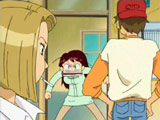

Quick Links:
Animation Runner Kuromi
An anime about making anime may sound like some sort of dull documentary, but Akitaro Daichi has taken this bland subject and made it into quite an interesting title. Combining real-life experiences (according to Daichi, 99% of the film is based on something that happened to him) with just a touch of insanity, Animation Runner Kuromi manages to give anime fans a chance to take a humorous journey through the production of an anime series from the producer's point of view.
Mikiko Oguro, also known as Kuromi, is just starting her new job at the animation studio, Studio Petit. But when she arrives, the place is deserted save for her superior, Oppama. Before he can explain Kuromi's duties, Oppama is rushed to the hospital for an ulcer. All Kuromi knows is that the studio is working on Time Journeys episode 2, and is into the key animation phase. With Oppama gone, Kuromi is given the "wonderful" position at the production desk. Unfortunately, there is only one week remaining until the deadline and Kuromi is in charge of possibly the ultimate team of slackers. Now it's up to her to motivate the crew and get Time Journeys 2 finished in time for production. Will she make it and save the show, or will the project turn into the disaster of the century?
While an anime about, well... making anime seems like a dull concept on paper, Daichi has executed it very well in a 45-minute OVA. Taking a key from Kodomo no Omocha (complete with Babbit-esque "helpers"), the series manages to be spastic for most of the time, moderated by a light sprinkling of somber points that show the gentle side of the cast. While these serious moments aren't as extreme as Kodocha, they still have an interesting influence on the overall product. The spastic parts are the meat of the feature though, with some genuinely funny moments that had me laughing out loud. Even though it is quite short, Kuromi builds up an amazing amount of momentum that leads to an interesting twist climax near the end. Daichi has definitely given this feature his golden touch, taking a borderline topic and making it a fun and interesting inside look at the animation world.
As the old saying goes, "No matter how good a story is, if the characters are bad then people will lose interest." Fortunately, the creative team seems to have listened to this advice and created a cast that is both loveable and hilarious at the same time. Being charicatures of at least one real-life personality (most are a combination of 2 to four), the characters have no shortage of flaire. Stylistically, Kuromi's characters are nothing short of fun and interesting. From the overly obese and lazy Haryu, to the ever hopeful Kuromi, the cast is varied, but still manages to balance itself.
Following the Kodocha formula, Kuromi seems to follow a very loose animation style that varies from scene to scene. Most of the show animates rather nicely, but there are several sections where the animation is reduced to low-detail versions of the characters to convey a situation. Fortunately, this works quite well in the context of the show and helps to give the viewers a better sense of how the character is doing emotionally. Depending on the tone of the scene, the animation ranges from silky smooth to comically jerky. Unfortunately, the number of eyecatches used borders on absurd, and detracts a bit from the overall experience. Other than this minor qualm, the product is smooth and creates a polished presentation overall.
Interestingly enough, even though Kuromi is only a 45-minute OVA, there is still quite a mix of music. For instance, there are two opening and ending songs: one set for the feature itself, and one set for Time Journeys. Speaking of the opening, this song is also the overall "theme" of the show, being used in several situations across the show. Unfortunately, this is the only piece used really thematically; the other six pieces don't end up being used more than once or twice each. This is quite a shame, as there are a few pieces that could have strengthened the show's atmosphere if applied to other sections.
While on the subject of sound, I must take a moment to applaud the vocal performances on both parts. The Japanese track is very strong, as usual, putting on an excellent performance. On the other hand, the English track is also excellent, rising above typical quality, without the usual problem of voices that don't fit their characters. A few puns did not translate quite so well to English, but that is unavoidable. Even so, the end result is a very clean and satisfying product that's enjoyable on either track.
On a technical note, Central Park has done an excellent job in presenting this feature on DVD. The video quality is excellent with no cases of aliasing. That said, there are a few instances of cross-coloration in a few of the "busier" sections that have a lot of lines close together. In general, though, the colors are vibrant, with no signs of artifacts. The sound is clear with no distortion or dropouts.
Central Park Media has managed to one-up the region two release bonuses again with Kuromi's impressive list of extra features. The laundry list begins with two art galleries: one of production sketches, and another with screens from the show. Next comes a pair of interviews, one with voice actress Lisa Ortiz, and one with the famous Akitaroh Daichi. Also included is a behind the scenes look at the Yumeta Company. To give insight from the animation scene on this side of the pond, Central Park has given viewers a short piece in which animator Matt Sheridan offers his views on the animation market, and how it compares and contrasts between here and in Japan. The requisite trailers that were used for the show are also included. Of course, the greatest bonus feature would have to be the combination of a full commentary by Akitaroh Daichi, and the option to view the entire film in storyboard form via an alternate angle. Simply stated, the US release of Animation Runner Kuromi shines with so much polish that it may make even a few fans from Japan jealous of its treatment.
For fans of Daichi, Animation Runner Kuromi is a must-have. For more casual viewers, Kuromi still comes with a high recommendation. While it sounds as if Kuromi would be a train wreck in anime, everything astoundingly comes together to create what could be Daichi's best comedic work since Kodocha.
Distributor: Central Park Media Creator: Yumeta Co. Released: 2003
Plot: A Character Design: A+ Animation Quality: B+ Music: B+ Overall: A-



